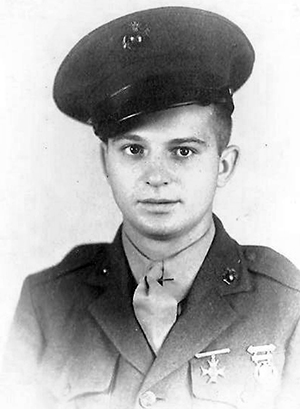Richard Johnson Wehr
PFC Richard J. Wehr served with Headquarters Company, First Battalion, 7th Marines.
He was killed in action at Guadalcanal, Solomon Islands, on 24 September 1942.
Branch
Marine Corps Regular
Service Number 364854
Current Status
Remains Not Recovered
Pursuit Category
This case is under Active Pursuit by the DPAA.
Capsule History
Pre-War Life
Birth
October 21, 1918
at Philadelphia, PA
Parents
Stewart Alexander Wehr
Barbara (Harrer) Wehr
Education
Details unknown
Occupation & Employer
Rubber worker
Castle Rubber Company
Service Life
Entered Service
September 30, 1940
at Pittsburgh, PA
Home Of Record
217 West Brady Street
Butler, PA
Next Of Kin
Mother, Mrs. Barbara Wehr
Military Specialty
Runner (Battalion CO)
Primary Unit
HQ/1/7th Marines
Campaigns Served
Guadalcanal
Individual Decorations
Purple Heart
Additional Service Details
Richard was engaged to Hettie Leary of North Carolina; they met in Goldsboro, where she worked at the USO canteen.
Loss And Burial
Circumstances Of Loss
On 24 September 1942 – six days after arriving on Guadalcanal – the First Battalion, 7th Marines departed from the Lunga Perimeter and headed out into Guadalcanal’s backcountry. They followed a trail known as the “Maizuru Road” which had served as a Japanese advance and retreat route during the battle for Edson’s Ridge. The battalion commander, Lt. Col. Lewis B. “Chesty” Puller, hoped to cross the Matanikau River at an undefended point, then advance along the Japanese-held bank to outflank enemy fortifications. This maneuver was a crucial part of a planned offensive scheduled to begin on 26 September.
After an exhausting day-long hike, the battalion reached a stream bed and began searching for a suitable bivouac. While the rearguard (Company C and Company D) occupied a defendable hill, Companies A and B advanced to the riverbank and sent scouts into the woods beyond. A Marine squad surprised a pair of Japanese troops cooking rice, and killed them with a flurry of gunshots. Puller, never far behind his point squad, appeared to survey the scene. With him was his runner, PFC Richard J. Wehr. Puller picked up a Japanese bowl and made a show of dipping it into the rice pot to sample the enemy’s cooking.
The gunfire alerted a Japanese rearguard detachment in the area, and multiple machine guns suddenly opened fire. The first volley narrowly missed Puller – some accounts say that the rice bowl was shot from his hand – but PFC Wehr was not so lucky. He fell to the ground with a bullet in his throat and died shortly thereafter. The ensuing firefight cost the lives of ten Marines and wounded an additional two dozen before Puller managed to break contact and withdraw his men to a nearby hill for the night.

Burial Information or Disposition
Early on 25 September, Puller’s men set out to locate and bury their friends. The ten fatal casualties were buried in two groups of five – one on “Hill X,” the reserve position, and one on “Hill Y,” closer to the scene of the firefight. The bodies of PFC Wehr, Karnaghon, Pimentel, Edwinson, and Cockrell were carried to a ridgeline to increase the likelihood that future patrols would spot the graves. Identifying information was placed into the dead men’s canteens, and a dog tag was buried with each body. Finally, small markers were placed and the Marines said their goodbyes.
The battalion departed soon after the final grave was dug: two companies returned to the perimeter with the wounded, while Puller pressed on with Company C and reinforcements from 2/5th Marines. The remote location was rarely, if ever, seen by American troops for the rest of the battle.
Two post-war expeditions (1947 and 1949) failed to locate the graves of Puller’s men, and all were declared non-recoverable.
The Hill X and Hill Y sites were prioritized by the DPAA starting in 2012. Subsequent archaeological digs have returned possible remains, identification tags, and additional material evidence from the area. To date, no official identification of PFC Wehr has been announced.
Memorials
Manila American Cemetery and Memorial
Richard Wehr left a pair of identification tags and his St. Christopher medallion with his fiancee Hettie Leary. She kept the mementos until she passed away in 2010, at which point they were returned to the Wehr family.
Next Of Kin Address
Address of mother, Mrs. Barbara Wehr.
Location Of Loss
Approximate location of Hill Y – now the outskirts of Honiara, Guadalcanal.
Related Profiles
Buried in the field, Hills X and Y, as result of Maizuru Ambush.

Leaving Mac Behind: The Lost Marines of Guadalcanal
Willie Rowe, or someone who sounded a lot like Willie, was crying in the darkness.
PFC Gerald White could not blame Willie. He felt a bit like crying himself. His battalion of the 7t Marines left the Lunga perimeter full of fight, ready to prove they were no Johnny-come-lately laggards but the warriors who would turn the tide on Guadalcanal. Now they were a “weary and dejected band” dug in on a nameless hill overlooking an unfamiliar stream, an anonymous location with no known landmarks save those they named themselves. The field where Fuller found the cooking fire; the ridge their guns were on; the tree where Goble hid; the trail where Randolph died.
Unremarkable places, except that men bled for them.
Read more about the Maizuru Ambush in "Leaving Mac Behind."
Click the cover for details.
